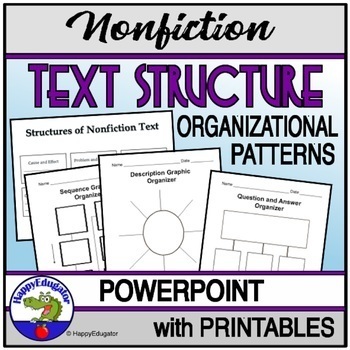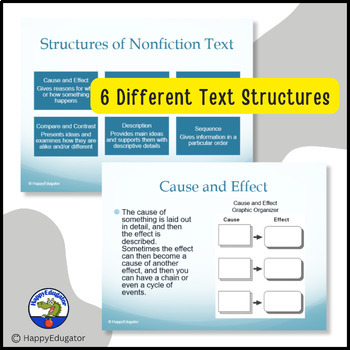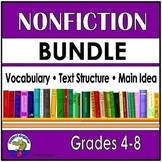Nonfiction Text Structure PowerPoint with Printable Graphic Organizers
- PPTX
- Microsoft OneDrive
Also included in
- Nonfiction Bundle for Grades 4 - 8. I have bundled several of my best-selling nonfiction products so you can save! Includes nonfiction vocabulary resources, text structure, main idea, book report, graphic organizer. To preview this resource, click on the following links to the products that are inclPrice $22.60Original Price $28.25Save $5.65
Description
Nonfiction Text Structure PowerPoint. Clearly describes nonfiction organizational patterns or informational text structure. 6 different text structures, including cause and effect, comparison/contrast, and sequence, question and answer, problem and solution, and description. The slides discuss each structure separately and offer what signal words to look for in each type of text. A printable graphic organizer accompanies each type of structure. Supports Common Core State Standards for Reading Informational Text. Selections for practice included (along with a recipe you are sure to enjoy) This digital resource has animated graphics to engage your learners. Helps students recognize different text structure when reading and provides a foundation for expository writing. Use in Zoom for remote learning, share with your students in OneDrive or Teams, or upload to Google Drive and save as Slides, and it will convert for use in Google Classroom. It is editable and easy to adjust if necessary. 31 slides. Includes printable graphic organizers. View in Slideshow mode. Please see full preview.
Buy the bundle and save! This product is now included in:
You may also like:
Writing Expository Paragraphs - Writing Practice Activity
Nonfiction Vocabulary You Should Know PowerPoint
CCSS.ELA-Literacy.RI.4.5 Describe the overall structure (e.g., chronology, comparison, cause/effect, problem/solution) of events, ideas, concepts, or information in a text or part of a text.
CCSS.ELA-Literacy.RI.5.5 Compare and contrast the overall structure (e.g., chronology, comparison, cause/effect, problem/solution) of events, ideas, concepts, or information in two or more texts.
CCSS.ELA-Literacy.RI.6.5 Analyze how a particular sentence, paragraph, chapter, or section fits into the overall structure of a text and contributes to the development of the ideas.
CCSS.ELA-Literacy.RI.7.5 Analyze the structure an author uses to organize a text, including how the major sections contribute to the whole and to the development of the ideas.
Follow me HERE to get notified of updates, sales, free resources, and new products. All new products are 50% off for 48 hours.
© Deborah Hayes aka HappyEdugator. For classroom and homeschool use. Your purchase buys one license. You may purchase extra licenses at a discount.
24305






